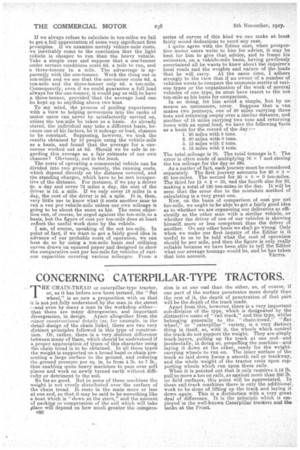CONCERNING CATERPILLAR-TYPE TRACTORS.
Page 16

If you've noticed an error in this article please click here to report it so we can fix it.
THE' CHAIN-TREAD or caterpillar-type tractor, or, as it has before now been termed, the "flat wheel," is so new a proposition with us that it is not yet fully understood by the man in the street —and even by many a man in the workshop either— that there are many divergencies, and important divergencies, in design. Apart altogether from the !ninor constructional details (as, for example, in the • detail desivi of the chain links), there are two very distinct principles followed in this type of construction. Or, rather, there-is a very distinct difference between many of them, which should be understood if a proper appreciation of types of this character using the chain tread is to be obtained. In all these types the weight is supported on a broad band or chain pre-. seating a large surface to the ground, and reducing the ground pressure per sq. in. to from 4 lb. to 7 lb., thus enabling quite heavy machines to pass over soft places and work on newly turned earth without difficulty or detriment to the soil.
So far so good. But in some of these machines the weight is not evenly distributed over -the surface of the chain tread. It rests in the main more or less at one end, so that it may be said to be something like a boat which is "down at the stern," and the amount ef packing or compression of the soil which will take place will depend on how much greater the compres
n50
sion is at one end than the other, as, of course, if one part of -the surface penetrates more deeply than the rest of it, the depth of penetration of that part will be the depth of the track made. Apart from this, however, there is a very important sub-division of the type, Which is designated by the distinctive name of "rail track," and this type, whilst belonging generally, to the "chain-tread," "flat , wheel," or " caterpillar" variety, is a very distinct thing in itself, as, with it, the wheels which control the track do not support the weight. They are simply track-layers, pulling up the track at one end—and
i incidentally, n doing so, propelling the machine—and laying it down at the other, ready for the weightcarrying wheels to run on. The inner surface of the track so laid down forms a smooth rail or trackway, and the whole weight of the tractor rests upon supporting wheels which run upon these rails.
When it is pointed out that it only requires 5.16 lb. pull to move a ton on rails, as against more than 250 lb. on field surfaces, this point will be appreciated. In these rail-track machines there is only the additional, work to be done of lifting up the track and laying it down. again. This is a distinction with a very great deal of difference. It is the principle which is employed in the well-known Caterpillar tractors and the tanks at the Front.






















